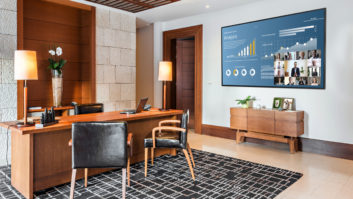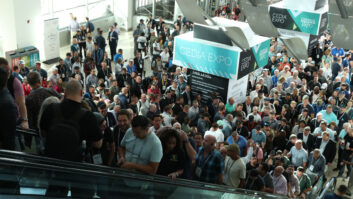They call this 16×9 thing that we get on DVDs, plasma screens, and many projectors today “widescreen.” But you ain’t seen nothing yet! Imagine a screen as wide as the Cinemascope screens that you see in first-run cinemas. Now imagine this in your customer’s home, complete with motorized masking and super-high-quality picture. Now, you’re talking!
The aspect ratio of the top-run movies put out by Hollywood is typically 2.35 times wider than it is tall. Known as “scope,” it is the process of creating a wide rectangular picture by using a lens on the camera that squeezes the picture content onto the 1.33:1 ratio film frames. All of the content looks tall and skinny, and the film folks call this a “squeezed” print. During projection, a lens is fitted on the projector that “un-squeezes” the picture by distorting it back to a rectangular shape. This lens is called “anamorphic” because it unequally magnifies the picture along the horizontal and vertical perpendicular axes.
Many films are also shot in 1.85:1 ratio. This process is simpler and lower quality. The 1.33:1 film frame is filled with more picture content than intended, and the top and bottom are cut off during projection to reveal only a rectangular portion of the picture. This print is known as a “flat” print.
High-definition video is set up for 1.78:1 (16 divided by 9) and corresponds to neither of the above film formats. The 1.85 aspect ratio is pretty close to 1.78, so you can get away with presenting it on a 16×9 screen with only small black fill bands at the top and bottom, or you can overscan the picture.
But what about showing a 2.35:1 scope film on a 16×9 display? You will invariably end up with significant black bands, and boy is that unsightly. Worse yet, you aren’t using all the pixels and scan lines available on your display, thereby reducing the apparent resolution of the picture. That’s the last thing you want to do. So now what? You could zoom the picture to fill up the top and bottom of the screen, but then you will lose the left and right picture content. Or, you could start off with a wider screen than 1.78:1 and maintain the entire picture content, but you will still not be using all the pixels, because you are projecting black bands above and below the screen. Darn! So what to do?
Good news is that a few smart cookies just figured that out. Here’s the plan: with 2.35:1 picture content, remap the video frames to make the top of the active picture content (just below the black letterbox bands) actually go to the projector’s top row of pixels. Do the same for the bottom of the picture content. Now you have distorted geometry, with everything looking tall and skinny. No problem, because the next step is to put an anamorphic lens in front of the projector, just like the film guys do in cinemas. Now you get a 2.35:1 picture, correctly proportioned, using the entire imaging device of the projector. The result is a brighter picture with better resolution and no wasted black video above and below the screen.
Here’s the recipe for 2.35 screen setups:
1) Figure out the target width and height for a decent 1.78:1 screen in the room. The parameters should be that the 1.78:1 screen width is 0.55 of the seating distance. This will give you a 30-degree subtended viewing angle, which is appropriate for DVDs. The other parameter is that the screen height dimension (which is the width you just calculated divided by 1.78) should be such that sightlines are good for all viewers in the room. If you need to raise the screen to improve sightlines, make sure that the viewers don’t have to look up more than 15 degrees from horizontal.
2) Figure out the total open screen dimension. This is the height that you just calculated multiplied by 2.35. Make sure there’s enough room in the home theater for this big screen, and make sure the screen or screen frame isn’t covering your left and right speakers. In all cases, I recommend using an acoustically transparent screen material, so that the center speaker can be in the middle of the screen, and the left and right speakers can also be placed behind the screen, if necessary. Typically, I would still leave the left/right speakers flanking the screen, because they need a greater subtended angle than your screen will cover.
3) Select a screen with motorized lateral masking. The masking stops should be, fully open, at 1.85:1 and 1.78:1; 1.66:1; and 1.33:1. You will share a setting for 1.78 and 1.85, which is acceptable because it means losing only four percent of the vertical picture area through overscan in 1.78 mode. In all cases, the picture height remains the same and only the width changes. By the way, the 1.66:1 stop is for some European and Japanese productions that will end up with gray bars on the left and right of the picture if it is transferred anamorphically to DVD.
4) Program the motorized masking for the source material. Typically you will have manual settings, but with systems using film library databases and video servers, you can actually automate the feature. The Gracenote database is one that includes the aspect ratio details you need for proper automation.
5) Select a projector with a 2.35 anamorphic lens attachment. Ideally the lens is controlled electrically and slides in front of the main lens when needed. Right now, Runco makes this feature available on several projectors with its AutoScope lense. Lens attachments for other projectors should be available very soon, including one from ISCO Precision Optics.
6) Select a scan converter that can remap the image to fill out the imaging device of the projector. Most of Runco’s better projectors offer this feature, known as CineWide. When the Cinema mode is enabled on the controllers of those projectors, a trigger signal is sent out to the motorized AutoScope lens to move it into place.
7) Program the system automation to control the scan converter, the anamorphic lens, and the screen masking simultaneously.
8) Install and calibrate the projector so that it overscans four percent in the 1.78 and 2.35 modes. This will present a 1.85 picture with the letterbox bars right at the frame’s edge.
With the concept of a 2.35 aspect ratio screen with constant picture height as you move through formats from 1.33 up to 2.35, you naturally build a hierarchy in the presentation. Broadcast TV gets the smallest picture area; DVD gets a larger area; and action films, preferably in HD, get top billing with the largest, widest, and most dramatic presentation. This is truly special, and clearly something that the basic plasma TV retailer can’t touch. You get a really big screen with no sightline issues, and you are ready for the future. What’s in the future? Maybe Ultra High Definition with 4,000 scanning lines and the definite achievement of cinematic 2.35:1 presentations in the home. You might as well give your customers the system infrastructure for that right now and amaze them with the results. Go wide!
Chase Walton contributed to this article.







